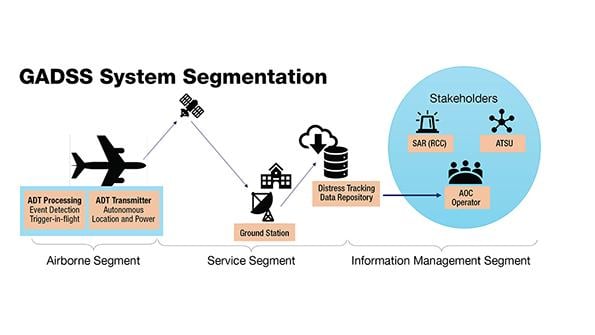
Most commercial airliners already had satellite communications systems that complied with an international standard requiring an aircraft under normal flight conditions to report its position at least every 15 min., a rule that became effective in November 2018.
The next step in implementing the Global Aeronautical Distress and Safety System (GADSS)—providing a capability for autonomous distress tracking (ADT) position reporting at 1-min. intervals by 2021—has proven more challenging. In March, the International Civil Aviation Organization (ICAO) Council postponed the ADT requirement for new-build aircraft by two years, to 2023.
The ADT topic was raised during the 40th session of the 193-member--state ICAO Assembly last October, “and subsequently the ICAO Air Navigation Commission determined through a series of consultations that industry wasn’t ready yet and therefore countries wouldn’t be able to realistically enforce the original deadline,” says the U.N. agency’s communications office.
ICAO’s Annex 6, Part I, Section 6.18.1 requirement that new-build aircraft with a maximum takeoff weight (MTOW) of more than 27,000 kg (59,525 lb.) autonomously transmit position data at least once every minute will now enter force on Jan. 1, 2023. The ADT standard is recommended, but not required, for aircraft weighing more than 5,700 kg.
Impetus to establish the GADSS construct to exploit air-ground tracking technologies and develop a timely response to emergencies followed the still unresolved disappearance of a Malaysia Airlines Boeing 777-200ER in the Indian Ocean in March 2014 and the prolonged search for an Air France Airbus A330-203 after it crashed in the Atlantic Ocean in June 2009.
Two months after the disappearance of Malaysia Airlines Flight 370, ICAO convened a special meeting of industry and government experts at its Montreal headquarters, at which the GADSS concept was conceived.
Satellite connectivity provided by Iridium and Inmarsat spacecraft and aviation communications network providers ARINC and SITA already facilitated the GADSS 15-min. “normal” tracking standard. Another means of tracking transponding aircraft—-Aireon’s space-based automatic dependent surveillance-broadcast (ADS-B) system—entered service in March 2019.
But achieving the next planned GADSS implementation step for ADT at 1-min. intervals and an accompanying requirement for post-flight localization and recovery of flight data presents a challenge, Australia asserted in a working paper submitted to the ICAO Assembly. Cosponsored by New Zealand and South Africa, the paper asked the agency to poll its member states on their preparedness to meet the ADT standard by 2021.
“Full implementation of the ADT and accompanying post-flight localization and recovery requirements is dependent on the development, testing and certification of new technology and equipment for successful installation into new and (optionally) retrofitting existing aircraft,” Australia argued.
“In addition, there appears to be inconsistent awareness across states and industry of the GADSS, and a lack of coordination and information sharing between relevant ICAO technical panels and those responsible for SAR [search and rescue], leading to potential misunderstandings and differing interpretations.”
Industry sources say Boeing and Airbus lobbied regulators to extend the ADT compliance date to provide more time to modify their production lines for new equipment. The manufacturers, reportedly making vendor selections, did not provide information when asked about their progress toward implementing ADT forward-fit provisions.
An industry standardization group, the ARINC-SAE Airlines Electronic Engineering Committee (AEEC), published technical requirements, architectural options and recommended interface standards for an ADT system in August 2019. The AEEC reviewed system architectures and architecture combinations involving ADS-B, satellite communications and emergency locator transmitter distress tracking ELT(DT).
The European Union Aviation Safety Agency (EASA) has taken the lead in refining ICAO’s ADT mandate into a regulatory requirement for EU-registered airliners. In February, EASA released Notice of Proposed Amendment (NPA) 2020-03, containing amended certification specifications, acceptable means of compliance and guidance material to implement a regulation the EU published in December 2015.
The EU regulation—CAT.GEN.MPA.210—requires fitting some categories of large aircraft with a “robust and accurate means to locate the point of end of flight in case of a distress situation,” says EASA.
ICAO procedural standards for locating an aircraft in distress are contained in Annex 6 Part 1. According to EASA, the European Union’s CAT.GEN.MPA.210 regulation differs from the ICAO standards in several ways.
Whereas the ICAO requirements apply to aircraft with an MTOW of more than 27,000 kg, the EU specifies aircraft weighing more than 27,000 kg with passenger seating capacity of 19 or more and all aircraft with an MTOW exceeding 45,000 kg. The applicable event for ADT as defined by ICAO is an aircraft in distress; CAT.GEN.MPA.210 specifies an “accident where the airplane is severely damaged.”
The required means for distress tracking will be “autonomous transmission” by ICAO standard and “robust and automatic means” by the proposed European requirement, EASA says.
The NPA 2020-03 comment period ended May 29, and a review of the public input will take anywhere from a few weeks to months, says EASA. The agency will then publish final amendments to the regulation. CAT.GEN.MPA.210 applies to commercial air transport operators based in EU member states, for aircraft manufactured after Jan. 1, 2023.
Still to be released is an industry standard supporting the GADSS requirements for post-flight localization and recovery of flight recorder data. These apply to new aircraft with an MTOW of 27,000 kg and authorized to carry more than 19 passengers, for which an application for type certification is submitted on or after Jan. 1, 2021.
Industry guidance will be contained in Project Paper 681, which is under development by the ARINC-SAE Timely Recovery of Flight Data (TRFD) Working Group.
“The ICAO decision to postpone ADT requirements from 2021 to 2023 does not directly influence the TRFD deliverable. We anticipate completing the Project Paper 681 in early 2021 for acceptance at the ARINC General Session in May [2021],” the working group says in response to an Aviation Week inquiry.
“As a new aircraft model is developed and certified typically within five years, the first airplane model required to have TRFD would be 2026 at the earliest,” the working group adds.



